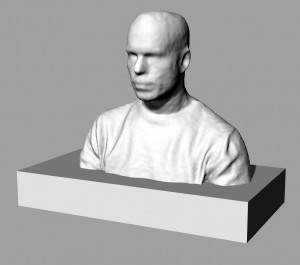1) Rotate part to desired orientation
2) Run the “fillmeshholes” command
3) To be 3-D printed, meshes must be watertight solids
- Check to see if mesh is solid by running the “what” command. In the description, a watertight mesh will be listed as closed.
- Alternatively, the “volume” command can be used to see if a mesh is solid. If a volume is specified with no warning then the mesh is okay. If, however, a warning appears about the mesh not being closed then you’ll have some work to do.
4) If an error occurs or you cannot close the mesh, run the “meshrepair” command and follow the prompts. You may need to adjust the settings and/or run this command a couple of times to fix all of the problems.

5) Once your mesh is closed, you’ll want to give it a flat bottom by doing as follows:
Create a NURBS box that intersects your mesh as shown below
Select the NURBS box and run the “mesh from NURBS object” command. This is one of the first options in the mesh menu at the top of the screen. (Or type “mesh” in the command line)
Run the “meshbooleandifference” command. Select your body mesh first, then the box. This command may take a few moments to process. Your result should be as shown below:
If the mesh boolean difference command repeatedly fails then you may need to create a new box with a mesh of greater density, as shown below.
If you want to join additional features to your mesh then you can use a similar process, but with the “meshbooleanunion” command
If you’d like to learn more about preparing Rhino files for 3D printing then watch this video: https://vimeo.com/80478910



